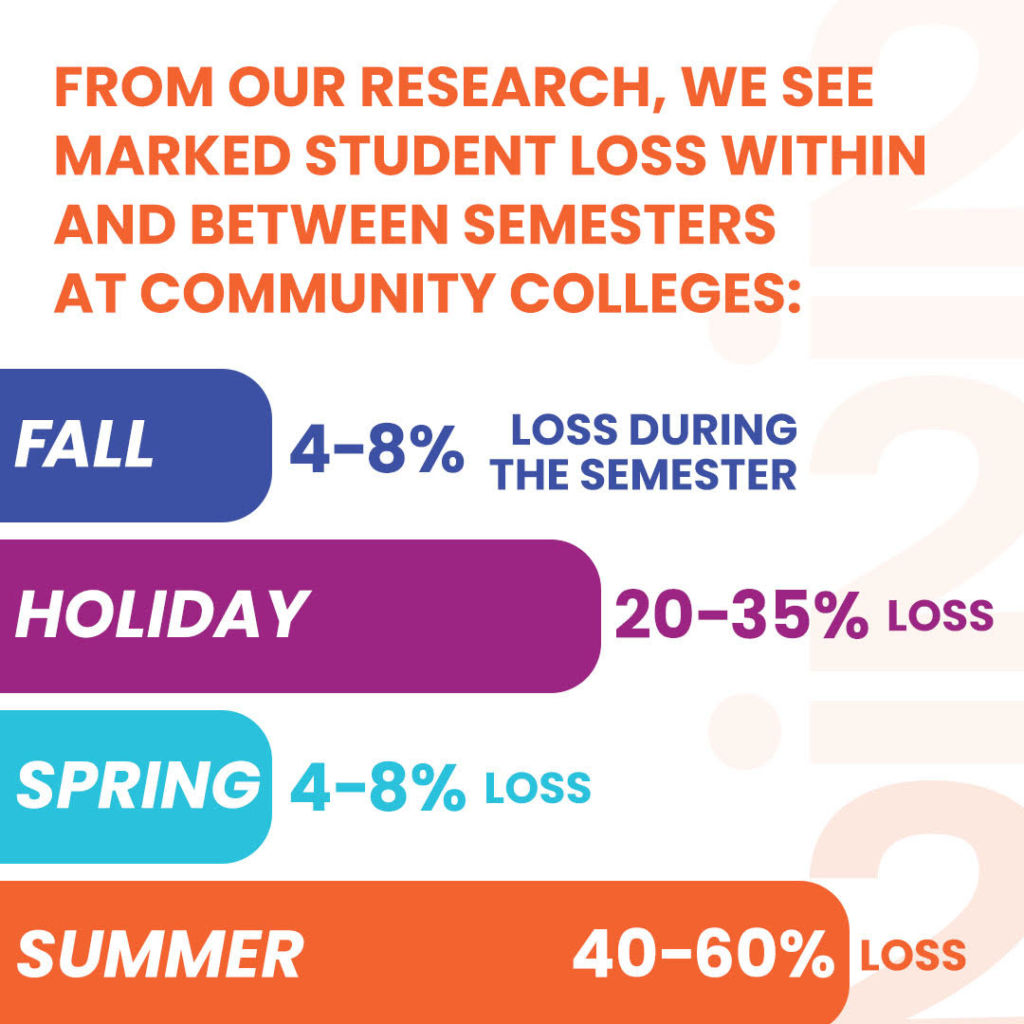“Summer melt” is a thing. And no, we’re not talking about popsicles. It describes the “melting away” of motivation for college students, both current and prospective.
Typically, the “melt” affects students who attend class in the spring and then fail to return in the fall. However, 60% of college-intending students between high school graduation and the beginning of their first college semester also fall victim to the phenomenon.
But what exactly is causing these students to “melt” through the cracks?

From our research, we see marked student loss within and between semesters at community colleges:
- During the fall semester, there is a 4-8% loss.
- Meanwhile, over winter break, community colleges typically lose 20-35%.
- Within the spring semester is a 4-8% loss.
- And over summer break, the dreaded “summer melt” loses 40-60%.
What makes this phenomenon even more perplexing is that when Interact surveyed students of nine Southern California community colleges in 2017 who applied but did not enroll, we found that 43% had actually completed their assessment testing.
That’s right! A full 22,000 students decided not to go to college after doing the “hard part.” Crazy, right?
If you’re still unconvinced, in August of 2017, Interact conducted a needs analysis of Los Angeles Community College District’s (LACCD) marketing and communications strategies and found the same thing—that nearly half of LACCD applicants failed to enroll after being accepted! Not surprisingly, the lower a student’s income, the more likely they were to “opt out.”
What Causes College Students to “Melt” Away?
While individual reasons for not enrolling vary widely, our broader research into “summer melt” reveals certain trends. Based on self-reported reasons from thousands of community college students across the country, failure to enroll tends to revolve around a couple of key issues:
- Lack of information for students
- Failure to have essential questions answered
- Lack of “friendly guidance” from counselors or enrollment staff
- Need for support when navigating confusing enrollment processes
However, alleviating the confusion, providing a clear pathway, and offering support are just a few ways to help students who often fall behind in the process. What are other common ways students fall susceptible to the summer melt?

Melting Through the Cracks
In addition to a general “failure to communicate,” our research also revealed common systemic failures that generally revolved around dealing with “special” circumstances. For example, prospects who do not speak English well enough to navigate the enrollment process or who have limited computer access tend to fall through the cracks because colleges haven’t established a protocol for addressing their needs.
These findings suggest something that we at Interact have long known: Personalized, professional, and timely communications play a key role in converting students from applied to enrolled.

10 Simple Ways to Put Summer Melt on Ice
However, if your college isn’t ready for something this extensive, don’t panic! There are a few things you could do to help put your summer melt over ice. Here are some simple strategies to think about:
1. Audit Your Pre-Enrollment Messaging Arc
When was the last time you did a thorough inventory of your pre-enrollment messaging? If it’s been a while, consider rounding up every letter, email, and postcard you can get your hands on.
Then, check out the following questions:
- Does your communication get across everything students need to know, or are you missing a crucial piece?
- Alternatively, are you overwhelming students with too much info, and do you need to break it down into bite-sized steps?
- Can you pinpoint any cold or unfriendly language, such as using all caps?
- Do students know where they can find support every step of the way?
Consider putting together a group of current students to read over your messages and give you some objective feedback about where you might be missing the mark. Or, feel free to set up a free consultation with us — we’d love to help!

2. Analyze Your Enrollment Pipeline
Put your best foot forward in trying to understand the different steps and obstacles students need to overcome on the way to enrollment.
Do you have a high number of students who may fall into those special circumstances, such as students who speak English as a second language? Make sure you’re aware of such students might get stuck in the enrollment journey and institute ways to help them through the enrollment process.
Talk to your institutional research person, and see the part of your pipeline where you’ve lost students in the past. Then, make a plan to bridge the gap.
3. Create Frequent Touchpoints and Communications
Students need constant connection, motivation, reminders, and support. You can establish these touchpoints through social media, digital outreach, email, text and print to encourage students to stay engaged and laser-focused on their college journey.
Our Media Prefs data from 2022 shows that students are frequently up against challenges like finances, mental health, work, and family emergencies. But on campus, they’re also fighting to understand some of your most basic processes — like registering for classes. You can read more about how to craft supportive messaging in our blog, “Want to Keep Students Motivated? Strengthen the Student Journey with 6 Creative Retention Techniques, Part 1.”

4. Use Personalized Emails and Texts
Don’t be afraid to reach out! Your students want to hear from you. One method to try is direct and personalized communication rather than relying on the organic reach of your social media profiles.
Text is highly engaging, especially if you have a two-way texting tool. That way, if you send out a message about financial aid, students can respond with questions, and you can reach out with assistance right away.
Direct emails are also a prime way to reach students, but they need to have subject lines that draw attention. Try including the student’s name in your subject line, and keep it personal and warm.
Above all, keep your language welcoming, and steer clear of cold, transactional messaging. For more messaging tips, check out “9 Powerful Tips to Stop Churning and Start Returning Stop-Out Students.”
5. Integrate Re-Marketing Strategies
This is a great method to capture those “warm” leads.
Basically, re-marketing is when you target website visitors with digital ads, which has a 10X click-through rate compared to regular display ads.
For example, say a student visits your financial aid page. You could target an ad to that visitor showcasing your upcoming financial aid application workshop.
This strategy can help keep your college top of mind … and keep students from falling victim to the melt!

6. Target Gatekeepers Like Parents and High School Counselors
Aim for messaging that empowers these gatekeepers to help incoming students stay on track. These influencers greatly impact students’ educational journeys, so leverage their voices to maximize your results and limited resources.
For a deep dive on all kinds of influencers, check out the Interact Rounds webinar recording, “Tapping into Student Influencers.”
7. Work Collaboratively to Fight Summer Melt
Sometimes, working in teams can help you get a fresh perspective on your messaging. Try partnering with counseling, admissions and student services to review, refresh, and recreate your outreach materials.
Comparing your efforts could help show redundancies or gaps in your communications. Take stock of your current messaging to be more helpful, relevant, and engaging to incoming and continuing students. Your teamwork could reveal key elements that may have been missing from your efforts.

8. Ensure Plans for Students With Unique Circumstances
Work closely with admissions and enrollment staff to ensure extra support is available for students with unique circumstances.
For example, if students need computer assistance, consider having a computer lab in academic counseling with open hours. You could have counselors and work-study students helping incoming first-years register for classes or fill out paperwork. This strategy is a double win for students who have issues accessing technology and WiFi.
9. Measure the Success of Your Communications
Keep an eye on your ROI to know when you are reaching students and when you’re falling short. Are you keeping track of your email open rate? What about your engagement and reach on social media?
Regularly review your analytics to know what’s working well and what needs improvement. Though it sounds obvious, often, we marketers get so involved in the day-to-day that we can forget to look at the big picture. That’s why it’s crucial to schedule a regular time to review performance metrics.

10. Review Your Outcomes
Are you hitting your benchmarks? How are your successes measuring up to your short- and long-term goals? How has your outreach improved since last year? Since five years ago?
On top of reviewing performance, it’s also critical to see how you are measuring up against your goals. If you fell short, start investigating where the gaps might have in your outreach and onboarding.
It’s also important to revisit and implement new retention strategies. Take a look at your current data, find new ways to engage with your students and clearly define student success goals.
It can even be helpful to take a deep dive into the summer melt strategies you’ve employed over the last few years and revisit your most successful campaigns. Sometimes, looking at past wins can give us the fuel for future innovations.
Finally, don’t be afraid to try new methods or implement a combination of several strategies from this list to freeze summer melt!
Summer Melt Conclusion
The ways you can craft your messaging strategies are infinite, but hopefully, these ideas give you a place to start.
If auditing your messaging arcs or reviewing your enrollment pipeline seems overwhelming, we’re always happy to help. Book a free 15-minute consultation to see how we can help you overcome your challenges.



